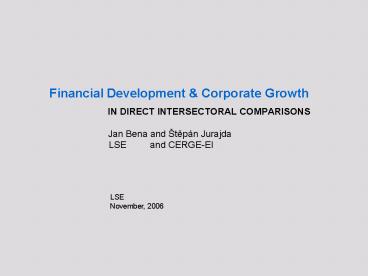Financial Development PowerPoint PPT Presentation
1 / 24
Title: Financial Development
1
Financial Development Corporate Growth
- IN DIRECT INTERSECTORAL COMPARISONS
Jan Bena and tepán Jurajda
LSE and CERGE-EI
LSE November, 2006
2
MOTIVATION
- There is positive cross-country correlation
between financial development and economic
activity (Goldsmith, 1969 King Levine, 1993). - Size of finance-growth effect?
- Finance-growth effect on particular firm types?
- But how can we disentangle two-way causality?
- Supply ? Firms need external finance to reap
growth opportunities. - Demand ? Financial development reflects future
growth opportunities. - Growth opportunities are unobservable.
- No episodes of exogenous changes in financial
development. - Identification relies on strong assumptions.
3
DEALING WITH REVERSE CAUSALITY Literature
- Cross-country studies
- Initial period indicators of country financial
development - (King and Levine, 1993 Levine and Zervos,
1998) - Instrumental variables, mostly legal origin
- (La Porta et al., 1998 Levine et al., 2000)
- Regional differences within a single country
- Controls for unobservable country-level growth
determinants - (Jayarante and Strahan, 1996 Bertrand et al.,
2004) - Experience of specific industries across
countries - Quantify industry need of external finance
- (Rajan and Zingales, 1998 Beck et al., 2004
Guiso et al., 2004)
4
THE RAJAN-ZINGALES STRATEGY Assumptions
- (A1) Industry growth opportunity shocks are
global - the same need to expand production
- (A2) Industry technology is also constant across
countries - the same of external finance to expand
production by a unit - ? Cross-industry differences in the need for
external finance are the same across countries. - (A3) U.S. listed firms face a perfectly elastic
supply of external finance. - ? Observed industry external finance dependence
in the U.S. (US_EFD) serves as counterfactual for
outside financing need in other countries.
5
THE RAJAN-ZINGALES STRATEGY Implementation
- Regress industry growth on
- country and global industry fixed effects
- interaction term US_EFDINDUSTRY
Financial_DevelopmentCOUNTRY - to ask whether industries more dependent on
outside finance grow faster in financially more
developed countries. - STRONG Reverse causality endogeneity at country
level. - WEAK Constant industry differences in demand
for external finance across countries such as
U.S., Finland, Philippines, Zimbabwe, ... - Direct tests of assumptions are not available.
- Similarity of technological content of industries
across development levels threatened by empirical
trade research (Schott, 2003).
6
AN ALTERNATIVE STRATEGY Assumptions
- (A1) Industry growth opportunity shocks are
global. - (A4) Corporate growth in a given industry would
be the same in absence of differences in country
financial development. - Apply both assumptions in a more appropriate
context - EU-15 single market,1995-2003 (harmonized
product market regulation) - Industry growth is verifiably highly synchronized
- Comparable firms Age, Size, Leverage,
Tangibility, Quoted, Ownership, ... - ? Do two comparable EU-15 firms in the same
industry but facing different financial system
grow at different rates?
7
AN ALTERNATIVE STRATEGY Cost and Benefits
- Benefits of (A4)
- Avoid quantification of industry EFD
- Obtain economically measurable estimates
- Costs of (A4)
- Heterogeneity in financial development in EU-15
assumed orthogonal to other country-level
determinants affecting growth. - ? Control for initial-period GDP to capture
convergence effects. - Use initial-period (predetermined) indicators of
country financial development. What if markets
are forward looking? - ? Control for country-level future growth
opportunities
8
BASIC SPECIFICATION
Gijkt a ßFDi ?GDPi dtj Xk'? eijkt
9
DATA
- Firm level Amadeus TOP 250 thousand for EU-15
- Real value-added growth of manufacturing firms
- Only public and private limited liability
companies - Remove state-owned firms
- Best firm-level EU data source available to date
- Country financial development indicators
- World Bank Financial Structure and Economic
Development Database - Total capitalization Includes debt securities
(Hartmann et al., 2006) - Control premium Private benefits of control
(Dyck Zingales, 2004) - Industry level OECD STAN
- Industry growth rates used to identify
synchronized industries.
10
CORPORATE DESCRIPTIVE STATISTICS Firm-Year Data
over 1995-2003
11
FINANCIAL DEVELOPMENT The EU-15 over 1990-1994
12
FINANCIAL DEVELOPMENT AND CORPORATE GROWTH Basic
Estimates
13
FINANCIAL DEVELOPMENT AND CORPORATE GROWTH Basic
Estimates
14
FOCUS ON SYNCHRONIZED INDUSTRIES
- Our strategy is based on (A1) synchronization of
industry growth shocks, - so it will fail where industry growth is driven
by local regulation. - Hence, we identify synchronized industries using
ANOVAs of industry growth with YEAR and COUNTRY
factors. - Synchronization corresponds to strong YEAR
factors. - Differentiate Low-, Medium-, and
High-synchronization industry groups. - Or use continuous synchronization measure.
15
DEVELOPMENT AND GROWTH Industry Synchronization
Groups
16
FIRM-TYPE INTERACTIONS
Gijkt a ß0FDi ß1xkFDi ?GDPi dtj
Xk'? eijkt
17
AGE Interaction
18
SIZE Interaction
19
COLLATERALIZATION Interaction
20
TANGIBILITY Interaction
21
ROBUSTNESS CHECKS
- Financial development measures misleading
- if they reflect not only differences in
available supply of finance, - but also demand for finance driven by future
country growth opportunities. - ? Control for predicted future country growth
- Take industry averages of EU-15 realized growth
over 1995-2003, and weight them by initial-period
country-level shares of each industry. - Robustness to removing UK and Greece
- Median Regressions
22
Robustness to AGGREGATE GROWTH OPPORTUNITIES
23
Robustness to Removing UNITED KINGDOM and GREECE
24
CONCLUSIONS
- We apply simple cross-country comparisons in an
appropriate setting - within EU-15,
- to synchronized industries,
- to many similar firms, both large and small.
- As a result, we obtain
- coefficients that translate to easy-to-interpret
magnitudes, - differences in the finance-growth effect by firm
types. - Findings
- Move from the least to the most developed
financial system within the EU-15 boosts firm
annual growth rate by 2 to 3 percentage points. - Young firms have limited access to financial
markets. - Ability to provide collateral helps to get
outside finance, especially if the firm is small
or young. - We do not find a size effect interaction.

